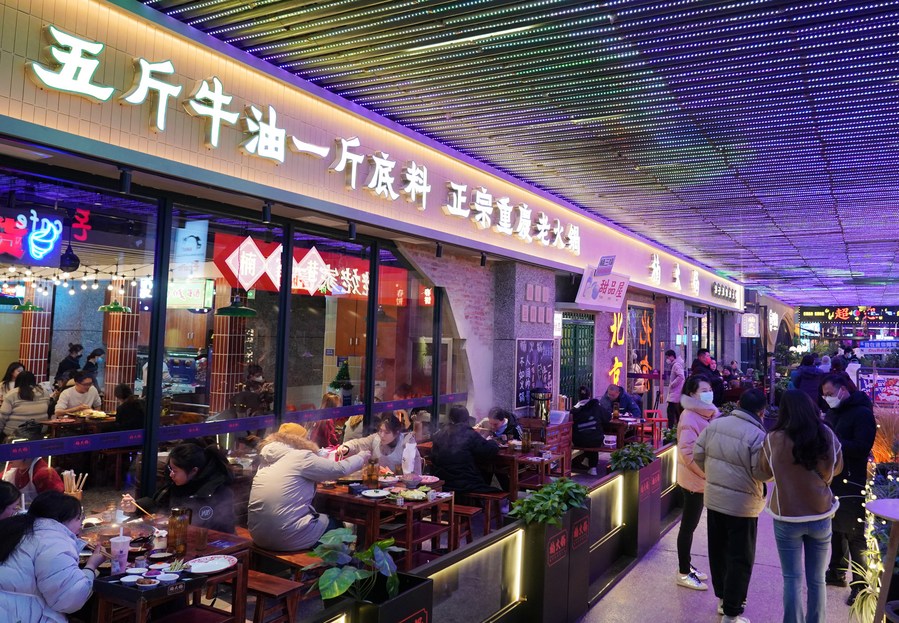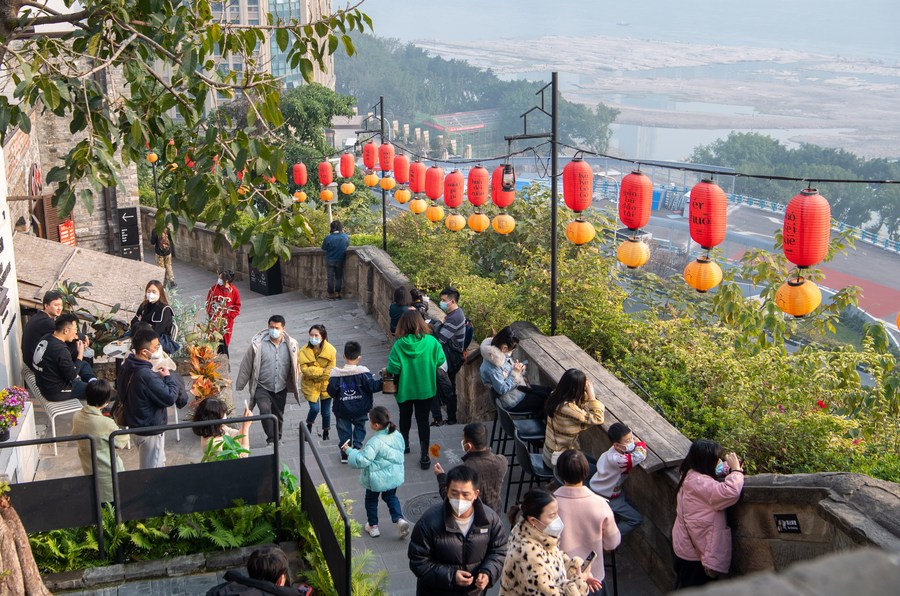People's lives, business recovering from COVID-19

Customers have meals at a restaurant of a business center in Beijing, capital of China, Dec. 25, 2022. (Xinhua/Zhang Chenlin)
BEIJING, Dec. 26 (Xinhua) -- The bustling traffic is back on the city streets, diners are consuming steaming meals again in restaurants, tourist destinations are buzzing with visitors, and factories are working against the clock to make up for delays caused by COVID-19.
Such are the signs that life and business are picking up pace around China amid the widespread adjustment in epidemic response following the release of 10 optimized measures on Dec. 7 to better coordinate anti-virus efforts and economic development.
WARMING SERVICE MARKETS
As China continues to optimize its epidemic prevention measures, restaurants in many places nationwide have resumed dine-in services, bringing back the hustle and bustle.
Waiters at a restaurant in Urumqi, Xinjiang Uygur Autonomous Region, are busy serving crispy baked buns and delicious chicken stew for customers, who sit at a safe distance from other groups.
The manager of the restaurant said that although the customer flow has not yet returned to normal, the resumption of sit-down meals has already boosted the confidence of the staff.

People visit Shancheng Alley of the Jiefangbei business district in Chongqing, southwest China, on Dec. 24, 2022. (Xinhua/Tang Yi)
"We are so glad that the customer flow has rebounded," said Hu Jianglong, deputy director of the management committee of the Jiefangbei central business district in southwest China's Chongqing Municipality.
The customer flow in this commercial complex has reached around 70 percent of the normal state.
The film market is also thawing. Currently, over 9,800 cinemas are in operation across the country, accounting for around 80 percent of the total number, according to professional box office tracker Dengta Data.
The reviving market saw "Avatar: The Way of Water" exceed 723 million yuan (about 103 million U.S. dollars) at the box office after 11 days of screening on the Chinese mainland.
In the retail market, a manager with the Wulin Intime department store in the eastern city of Hangzhou said that during the weekend of Dec. 17 to 18, the department store scored growth in both customer flow and sales, with both rising over 20 percent from the previous week.
The tourism market has seen a resurgence in many places, especially some warm cities in the south. Data from Alibaba's travel branch Fliggy shows that shortly after the release of the 10 optimized measures, the real-time search volume and booking volume of domestic air tickets and hotels increased substantially.
In the southern coastal city of Sanya, the bookings of some hotels saw a threefold increase from the previous week. On Dec. 18, the Sanya Phoenix International Airport carried out 319 passenger flights, an increase of over 134 percent over Dec. 7, while the passenger throughput was 42,765, an increase of 187 percent over Dec. 7.
"As policies continue to be optimized, the willingness of tourists to travel has recovered, boosting the confidence of the whole industry. We will seize the opportunity of New Year's Day and the Spring Festival holiday to launch more preferential products to help the industry revive," said Zheng Conghui, chairman of the Sanya Tourism and Culture Investment Group.
INDUSTRIAL RECOVERY
Companies have accelerated resuming production in the Beijing Economic-Technological Development Area (BDA), also dubbed Beijing E-Town, which is home to many high-tech firms in the capital city.
At a plant of one of its key enterprises, SMC Investment Management China Co., Ltd., staff are monitoring the operation of machines in its manufacturing and assembly workshops.
The company has seen stable performance in recent days and is well prepared for the strong order demand and economic recovery in the coming year, said Ma Qinghai, general manager of the wholly-owned subsidiary of Japan's pneumatic component manufacturer SMC Corporation.
"All-out efforts have been made to help companies expand capacity," said Kong Lei, director of the BDA Administrative Committee.
The BDA has taken tailored measures for companies within the area, including coordinating accommodations for employees, providing epidemic prevention supplies, facilitating personnel recruitment, streamlining supplies and logistics, funding assistance and cost reduction, according to Kong.
To help businesses accelerate the resumption of production while ensuring a safe working environment, various areas across China have formulated local measures.
In north China's Shanxi Province, relevant departments have been asked to inquire about the needs of companies on a regular basis and help them solve any problems in the process of resuming operations. Chongqing has unveiled a series of financial services for key industries.
Beijing allows people who have recovered from COVID-19 infection to return to work without nucleic acid or antigen tests, while central China's Hunan Province has launched multiple measures on logistics, electricity supply and land use.
These efforts have brought notable outcomes. The top 100 firms in the BDA have all resumed operations, and 99.5 percent of major projects in Chongqing have started construction again. Factories in Hunan have set new output records since November, with confidence restored.
Stabilizing growth, employment and prices, and ensuring an overall recovery and the improvement of economic performance were highlighted at the recent Central Economic Work Conference, which is an annual meeting to decide on the priorities for the economic work in the year ahead. Speeding up the resumption of work and production across the board plays a crucial role in securing these goals.
Photos
Related Stories
- China's Xinjiang gears up for economic recovery
- Investment fair displays global confidence in China's economic rebound
- Resilient China injects certainty into global economic recovery
- China to ensure stability in growth, employment and prices to keep major economic indicators within a proper range
- RCEP, BRI contribute to global post-pandemic recovery: academics
- Optimized epidemic response to help China achieve "J-curve" economic recovery
Copyright © 2022 People's Daily Online. All Rights Reserved.









